This post may contain affiliate links. Read more at our disclosure policy.
When looking for new roasts to cook on the smoker, a Smoked Chuck Roast will not disappoint. Often used for stews, this Chuck Roast is slowly smoked as a whole roast and then finished in a red wine braising liquid for a mouthful of flavor.
Want other creative ideas? Check out our “The Bear Inspired” Italian Pulled Beef Sliders featuring smoked Chuck Roast.

Table of Contents
This post is a collaboration with Beef. It’s What’s for Dinner. on behalf of the Beef Checkoff. I received compensation, but all opinions are my own. And our opinion is that this may be a new favorite roast idea for backyard cooking.
The Cut – Chuck Roast
Beef Chuck Roasts comes from the shoulder known as the Beef Chuck Primal. The most common way you will find the Chuck Roast at a butcher or market will be the Classic Chuck Roast or Cross Rib Roast. It is often referred to as Pot Roast (when used in a recipe) or Center Cut Roast.
The Chuck is a locamotion muscle that gets a lot of action and movement resulting in a lot of intramuscular fat. It is best when slowly braised or smoked in order to render the fat (and turn it into flavor). This rendering makes for a tender and delicious flavor like a classic steak.

Buying Chuck Roast
For this recipe, look for a Boneless Chuck Roast that is between 4 – 5 pounds in total weight. It is common to find the roast tied with butchers’ twine. When assessing quality be sure to look for good marbling, or intramuscular fat, which will help in getting the soft beefy and buttery texture. We have more details on Choice vs. Prime and how marbling plays into flavor. Regardless of the “rating”, pick the roast with the most marbling. This will be important when smoking and braising to get the tender texture we are looking for.
Preparation
For this recipe we are preparing to smoke the entire roast, versus cutting it up in smaller cubes like we would a stew. Keeping the roast intact will allow the smoke flavor to get into the entire roast, but also allow for the roast to keep its shape as it braises.
Trim off any excess silver skin or fat that may be along the outer edges of the meat and remove/discard any butchers’ twine. Coat the Chuck Roast in olive oil to allow the rub to stick and the liberally season with our beef rub.
Smoked Chuck Roast Seasoning
You can use any combination of rubs you enjoy, but a classic SPG rub — or kosher salt, coarse pepper, and granulated garlic — allows the beef flavor to shine and gives just the right amount of flavor to the braise. If you elect a more complex rub, just recognize that those flavors will also incorporate into braise.
How to Smoke A Chuck Roast
A Chuck Roast, like a Brisket or Plate Ribs, needs time to slowly cook allowing the fat pockets to basically melt and create a delicious tender meat. To do this we are going to smoke the roast first and then finish in the braising liquid.
Would you like to save this?
- Preheat your smoker to 250 degrees Fahrenheit using fruit, wood like apple or cherry.
- Place the seasoned chuck roast on the smoker and then insert a remote thermometer into the center of the roast to monitor the internal temperature of the roast.
- When the internal temperature of the smoked Chuck Roast reaches 165 degrees F, then it’s time to place the roast into the braising liquid, put a lid on the pot, and then finish in the smoker or oven until the roast is fork tender.
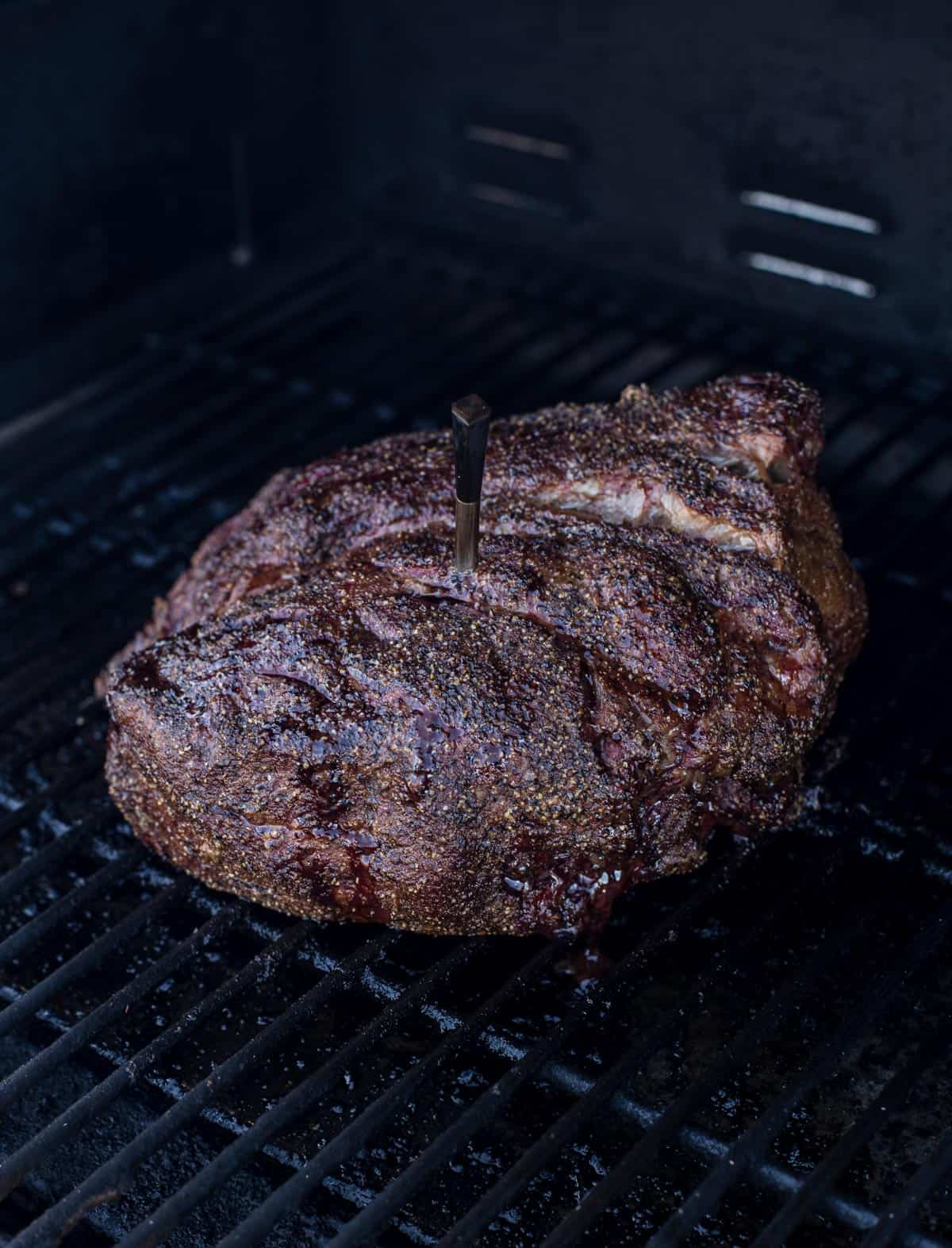
A device like the Meater+ is a great tool to monitor the cooking temperature from your phone so you can prep the braise at the right time.
The Red Wine Braise
We start the braising liquid when we see the internal temperature of the roast reach 155 degrees internal temperature. The purpose of the braise is to enhance the flavor of the roast and help it get fork tender while getting some of the smoke flavor from the roast into the liquid.
- Soften Vegetables: In a large Dutch Oven over medium heat add olive oil, onions, carrots, and celery and sauté until soft, but not browned (about 8 – 10 minutes). Next add garlic and sauté another 2 minutes, stirring.
- Add Liquids and Herbs: Add the wine and bring to a simmer for 5 minutes. Add the stock, canned tomatoes, herbs, and bring back to a simmer. At about this time the roast will be at or close to 165 degrees F, place the roast into the braising liquid and cover. Place the pot on the smoker.
- Increase the smoker to 325 degrees F and continue to braise for 2 hours or until the internal temperature of the roast reaches between 200 – 210 degrees F or until you probe the chuck with a fork and the fork goes into the chuck like butter. Remove from smoker for final step to thicken the braise.
- Thicken the Braise: Remove the roast and the herbs from the roast and set aside. Combine the flour and butter in a small bowl and add to the braising liquid. Bring the braising liquid to a simmer and stir for 5 minutes, as you stir it will thicken.
- Slice and Serve: Cut the roast into eight pieces, or shred the beef, and serve with the braise poured over the beef.
Why braise at 165? We start the braise at 165 so we can get as much smoke flavor into the roast as possible. It will still taste amazing if you add the roast into the braise at a lower temperature but in testing we found 165 is the best internal temperature to start the braise.
Chef’s Trick – Tie the herbs tightly in a bundle with kitchen string so you can easily remove them when the roast is done.

How Long to Smoke Chuck Roast per Pound
Plan 15 minutes per pound for a Choice or Prime smoked Chuck Roast. The leaner the roast, the faster it will cook. Regardless of time, be sure to pull the roast at the proper finishing temperature, which will range from 200 – 210 degrees Fahrenheit when the texture of the beef is like butter when using a thermometer probe.
Wine Pairing
A nicely balanced dry red wine with some moderate tannin is a great match for this dish. Since there’s wine in the dish feel free to use the same wine for cooking and also pairing. Cabernet Sauvignon and Bordeaux blends work wonders with this dish. You can also reach for a Malbec, Rioja crianza, Rhône blaends, or even Italian Barbera.
The Louis Martini 2017 Sonoma Cabernet Sauvignon is a great example with flavors of cherry and dark fruit with a balanced slightly acidic finish. And feel free to check out our guide on pairing wine with beef holiday roasts as well for more great ideas.
Other Holiday Beef Roast Ideas
- Smoked Prime Rib with Horseradish Butter
- Reverse Seared Beef Tenderloin
- Herb and Garlic Crust Smoked Prime Rib
- Grilled Picanha
- Smoked Brisket
- Beef Plate Ribs

Smoked Chuck Roast Stew with Red Wine Braise
Ingredients
- 1 5 pound Chuck Roast, trimmed, (look for something in the 4 – 5 pound range)
- 2 tablespoons extra virgin olive oil
- ¼ cup beef rub
Braising Stew
- 2 tablespoons extra virgin olive oil
- 2 cups diced white onion (about 1 medium onion)
- 4 carrots, sliced at a large bias
- 1 cup diced celery (about 3 full stalks of celery)
- 5 cloves garlic, peeled and crushed
- 2 cups dry red wine, (we used Louis Martini Cabernet Sauvignon)
- 1 28 ounce can of San Marzano tomatoes
- 1 cup beef stock
- 2 sprigs fresh rosemary
- 10 sprigs fresh thyme
- ½ teaspoon red chili pepper flakes
- ½ teaspoon kosher salt
- ½ teaspoon coarse black pepper
Thickening
- 2 tablespoons unsalted butter, as room temperature
- 2 tablespoons flour
Instructions
To Smoke the Chuck Roast
- Preheat smoker to 250 degrees Fahrenheit (F) using a fruit wood like apple or cherry.
- Coat Chuck Roast with olive oil and liberally apply the beef rub. Insert a temperature probe into the center of the roast and place on the smoker. Smoke for 3 hours, or until the internal temperature of the roast is 165 degrees F.
To Make the Pot Roast Stew
- When the internal temperature of the Chuck Roast is at 155 degrees F, start the stew. Place a Dutch oven on the stovetop over medium heat. Add olive oil, onions, carrots, and celery and sauté for 10 minutes or until soft and translucent but not browned. Add garlic and cook another 1 minute, stirring.
- Add the wine and bring to a simmer for 5 minutes. Add the tomatoes, stock, rosemary, thyme, chili pepper flakes, salt, and pepper bring back to a simmer. At about this time the roast will be at or close to 165 degrees F. When this happens, place the roast into the braising liquid and cover. Transfer the stew pot, with the chuck roast in it, onto the smoker.
- Increase the smoker to 325 degrees F and continue to braise for 2 hours or until the internal temperature of the roast reaches between 200 – 210 degrees F, or until you probe the chuck with a fork and the fork goes into the chuck like butter. Remove from smoker for final step to thicken the braise.
- Remove the roast and the herbs from the pot and set aside in a large bowl or a large cutting board.
- Combine the flour and butter in a small bowl and add to the braising liquid. Bring the braising liquid to a simmer and stir for 5 minutes, as you stir it will thicken.
- Cut the roast into eight pieces and serve with the liquid over mashed potatoes or on its own. Alternatively you can shred the beef (shredding the beef is actually my favorite way to serve this dish).
Video
Notes
Nutrition
Nutrition information is automatically calculated, so should only be used as an approximation.
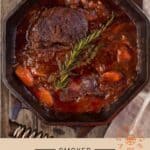

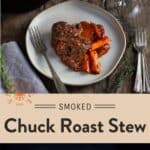


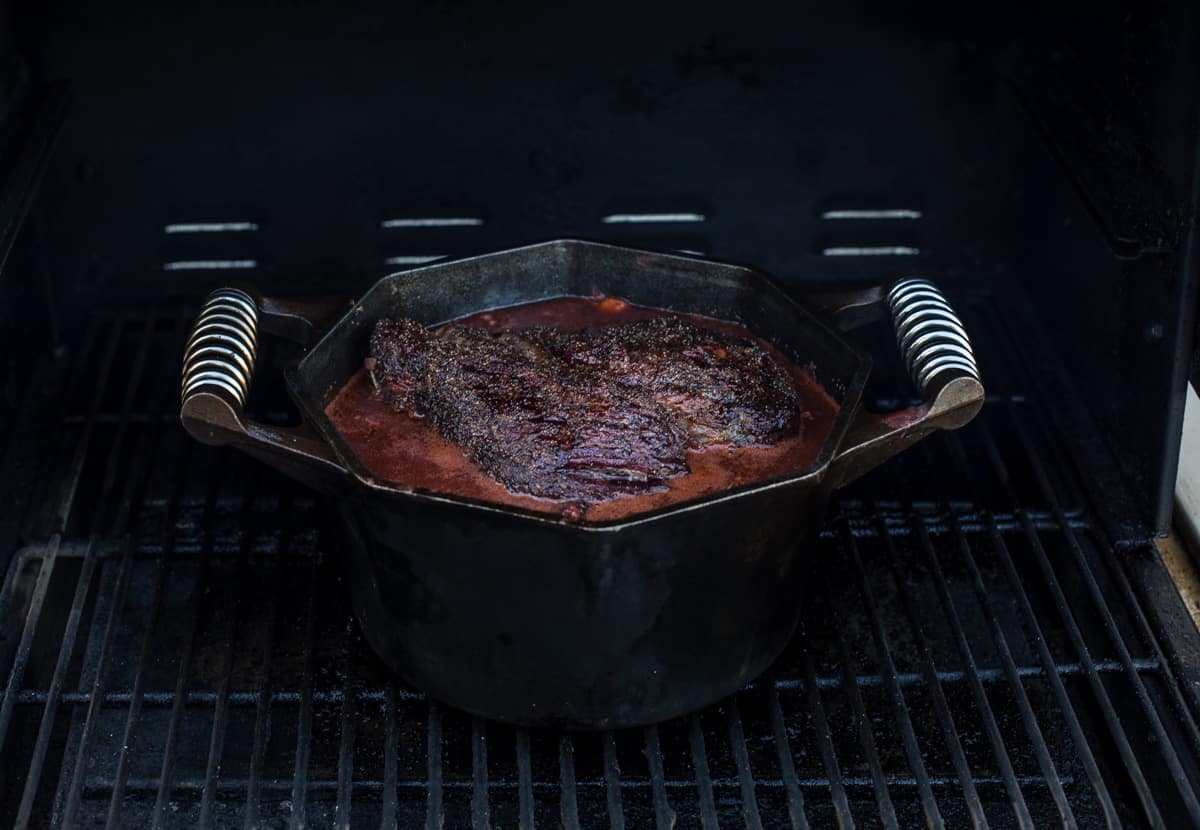

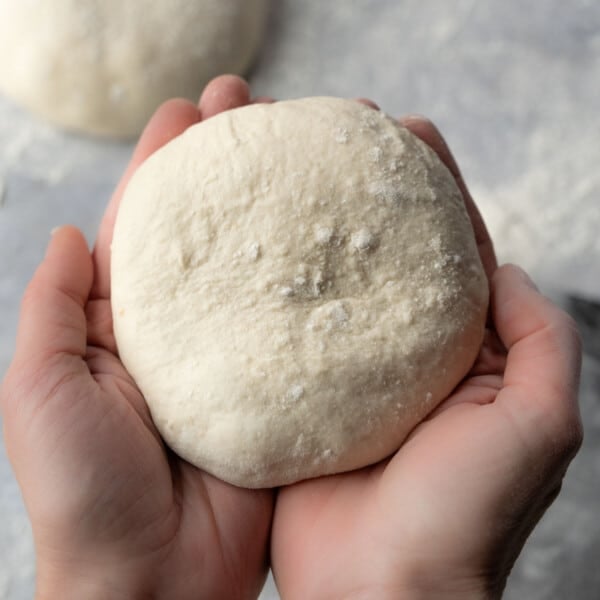
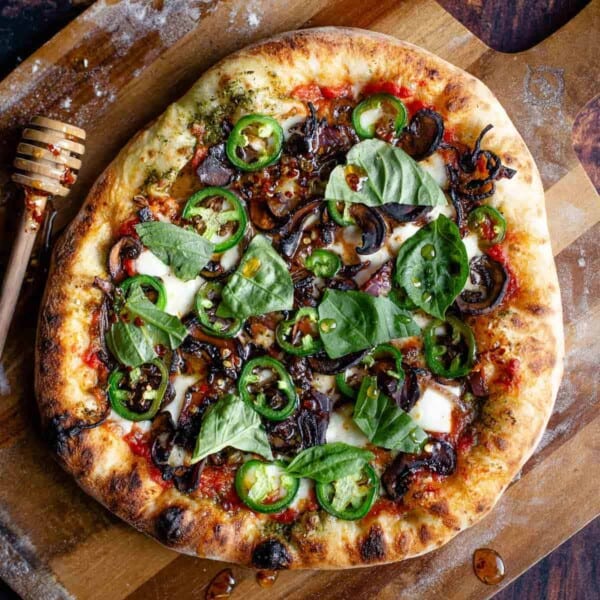


















Do you ever do this with additional veggies? Potatoes and carrots are the obvious ones, but what out-of-the-box things have you added? And when do you add them?
We absolutely do. We love fennel, any type of onion, parsnips, or really any root vegetable. We add any veggies during the sauté phase so they soften and brown slightly versus just simmer.
I cook often and have high standards, I rarely give a recipe a 5/5. This is without a doubt one of my favorite things to make. It’s fantastic. 5/5.
Awesome to hear, thanks so much for taking the time to share!!
Delicious. So glad I tried this recipe.
Does finishing the stew on the smoker for the last two hours of braising add more smoke flavor to the stew even though the lid is on the Dutch oven? If not, I was wondering if finishing the braising on the stove top would get the same results. Also, my husband is wanting to know if you use an offset smoker. Can’t wait to try this recipe!
Thanks!
Kathleen, great question. We simmer with the lid on, so it won’t take on more smoke. You could do it with the lid off, and still get a good smoked flavor to the chuck ribs. Otherwise, on the stove top is fine.
And yes, on an offset smoking chuck roasts would be the same. We have a Yoder offset smoker and would run the smoker between 250 and 275 for this recipe. Can’t wait to hear how it turns out!
Hi, I can’t wait to try this recipe. I am about to purchase my first Dutch oven…what size dutch oven would you recommend for a 5 lb chuck roast? Thank you!
David, can’t wait to hear how you like it! For Dutch Oven size, go for at least a 5-quart. It’s a great size for a 5 pound chuck roast, chili, and a host of other dishes for the family. Enamel Dutch ovens in the smoker will discolor, so be mindful of that when you purchase. We used the Finex 5-quart cast iron version (not enamel). There are other cast iron versions (non enamel) that are great too. Just want to be sure if you use it for smoking, that you know before you buy that the enamel will darken over time from the smoke. (So be careful if you go Le Creuset 🙂 )
Made this on Christmas Day. First time I have ever smoked a Chuck Roast. This recipe took Chuck Roast to a completely different level!! What a rich and savory dish! Everyone thoroughly enjoyed it. Thank you so much for sharing!!
Wow. This was the most amazing meal I have ever made. I used my Green Egg to smoke and cook the meal using hickory and cherry and the flavors were amazing. Thank you soo much for sharing this recipe with us. I look forward to more.
We are excited to try this for Christmas! Suggestions on whether to strain the braising liquid? Do you just leave the carrots and celery in there for thickening and serving? Thanks!
No need to strain. When you add the butter/flour mixture all of it will thicken. In some stew recipes it calls for blending the mixture, but we like the added texture of the whole vegetables.